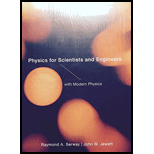
(a)
The frictional force exerted on the stopper by the nozzle.
(a)
Answer to Problem 44P
The frictional force exerted on the stopper by the nozzle is
Explanation of Solution
Given that the diameter of the hose is
Consider two points, point 1 at the free surface of the water in the tank and point 2 inside the nozzle.
Apply Bernoulli’s theorem to the given situation.
Here,
Reduce the expression (I) for
Since the pressure
The total force acting on the stopper must be zero.
Here,
Write the expression for the force exerted by water on the stopper.
Here,
Write the expression for the force exerted by air on the stopper.
Use equation (V), and (VI) in (IV) and solve for
Write the expression for the cross sectional area of the nozzle.
Here,
Use equation (III), and (VIII) in (VII).
Conclusion:
Substitute
Therefore, the frictional force exerted on the stopper by the nozzle is
(b)
The mass of water flows through the nozzle in
(b)
Answer to Problem 44P
The mass of water flows through the nozzle in
Explanation of Solution
Equation (II) gives the pressure difference at both ends of the stopper.
When the stopper is removed, the pressure on both points become atmospheric pressure
Write the expression for the mass of water leaving the nozzle.
Here,
Write the expression for the volume of water leaving the nozzle with speed
Use equation (XII) and (VIII) in (XI).
Conclusion:
Substitute
Substitute
Therefore, the mass of water flows through the nozzle in
(c)
The gauge pressure of the flowing water in the hose just behind the nozzle.
(c)
Answer to Problem 44P
The gauge pressure of the flowing water in the hose just behind the nozzle is
Explanation of Solution
Write the continuity equation for the flow of water through the hose and nozzle.
Here,
Solve equation (XIV) for
Rewrite equation (XV) in terms of the diameters of the hose and nozzle.
Rewrite equation (II) for the current situation, such that
Since the gauge pressure
Conclusion:
Substitute
Substitute
Therefore, the gauge pressure of the flowing water in the hose just behind the nozzle is
Want to see more full solutions like this?
Chapter 14 Solutions
Physics For Scientists And Engineers With Modern Physics, 9th Edition, The Ohio State University
- Pls help asaparrow_forwardPls help asaparrow_forward3. If the force of gravity stopped acting on the planets in our solar system, what would happen? a) They would spiral slowly towards the sun. b) They would continue in straight lines tangent to their orbits. c) They would continue to orbit the sun. d) They would fly straight away from the sun. e) They would spiral slowly away from the sun. 4. 1 The free-body diagram of a wagon being pulled along a horizontal surface is best represented by A F N B C 0 Ꭰ FN E a) A b) B c) C app app The app 10 app d) e) ס ח D E 10 apparrow_forward
- The acceleration of an object sliding along a frictionless ramp is inclined at an angle 0 is 9. a) g tano b) g cose c) g sino 10. d) g e) zero A 1.5 kg cart is pulled with a force of 7.3 N at an angle of 40° above the horizontal. If a kinetic friction force of 3.2 N acts against the motion, the cart's acceleration along the horizontal surface will be a) 5.0 m/s² b) 1.6 m/s² c) 2.4 m/s² 11. d) 1.0 m/s² e) 2.7 m/s² What is the net force acting on an object with a mass of 10 kg moving at a constant velocity of 10 m/s [North]? a) 100 N [North] b) 100 N [South] 10 N [North} d) 10 N [South] e) None of these.arrow_forwardModified True/False - indicate whether the sentence or statement is true or false. If the statement is false, correct the statement to make it true. 12. An object in uniform circular motion has a constant velocity while experiencing centripetal acceleration. 13. An object travelling in uniform circular motion experiences an outward centrifugal force that tends to pull the object out of the circular path. 14. An object with less inertia can resist changes in motion more than an object with more inertia. 15. For an object sliding on a horizontal surface with a horizontal applied force, the frictional force will always increase as the applied force increases.arrow_forwardPls help asaparrow_forward
 Principles of Physics: A Calculus-Based TextPhysicsISBN:9781133104261Author:Raymond A. Serway, John W. JewettPublisher:Cengage Learning
Principles of Physics: A Calculus-Based TextPhysicsISBN:9781133104261Author:Raymond A. Serway, John W. JewettPublisher:Cengage Learning Physics for Scientists and Engineers: Foundations...PhysicsISBN:9781133939146Author:Katz, Debora M.Publisher:Cengage Learning
Physics for Scientists and Engineers: Foundations...PhysicsISBN:9781133939146Author:Katz, Debora M.Publisher:Cengage Learning Physics for Scientists and Engineers, Technology ...PhysicsISBN:9781305116399Author:Raymond A. Serway, John W. JewettPublisher:Cengage Learning
Physics for Scientists and Engineers, Technology ...PhysicsISBN:9781305116399Author:Raymond A. Serway, John W. JewettPublisher:Cengage Learning College PhysicsPhysicsISBN:9781938168000Author:Paul Peter Urone, Roger HinrichsPublisher:OpenStax College
College PhysicsPhysicsISBN:9781938168000Author:Paul Peter Urone, Roger HinrichsPublisher:OpenStax College Physics for Scientists and EngineersPhysicsISBN:9781337553278Author:Raymond A. Serway, John W. JewettPublisher:Cengage Learning
Physics for Scientists and EngineersPhysicsISBN:9781337553278Author:Raymond A. Serway, John W. JewettPublisher:Cengage Learning Physics for Scientists and Engineers with Modern ...PhysicsISBN:9781337553292Author:Raymond A. Serway, John W. JewettPublisher:Cengage Learning
Physics for Scientists and Engineers with Modern ...PhysicsISBN:9781337553292Author:Raymond A. Serway, John W. JewettPublisher:Cengage Learning





